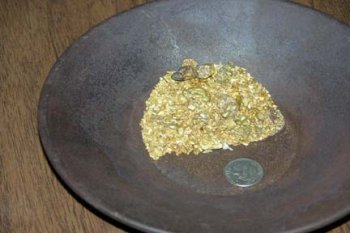
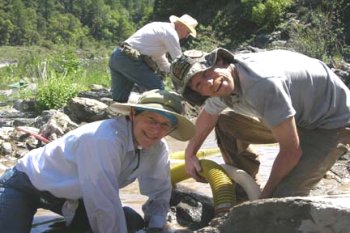
We just completed a fantastic week-long high-banking Group Mining Project on our Wingate claim, which is located downstream on the Klamath River about 10 miles from Happy Camp. We did last year’s surface mining project on the same claim, and recovered some really nice gold. Since we didn’t ever see any members return there to further develop the deposits we had discovered during last year’s Project, we decided to return there last week. This turned out to be a good move!
There were 18 of us involved with this most recent Project, including myself and my longtime, trusty assistant, Craig Colt. While there is some pretty good high-banking opportunity on the Highway 96 side, richer gold discoveries have been made on the very extensive area on the far side of the river. So we launched one of the Club’s large rubber rafts on the first day of this Project to go back over there and do some sampling. The raft was used all week to help ferry Project participants and all our gear across the river. We had excellent weather al week, bright blue skies and days which were not too hot out in the sun. We used to do these surface mining Projects (out of the water) during the (much) hotter month of August. Rescheduling them to June also turned out to be a good move.
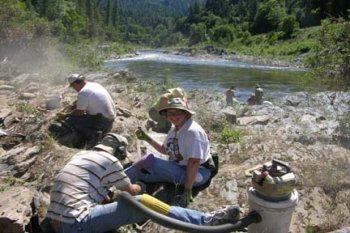 As we had a fair number of participants in this Project, we decided to split into two teams on the first day. I went to a lower portion of this claim along with everyone who had vack-mining machines and those who were interested in digging out crevices on a (very) large area of exposed bedrock. Last year, we discovered that all of the cracks and traps along the exposed bedrock were producing consistent rewards in fine gold and small flakes. This type of mining is relatively easy to do; because it is mainly a matter of sitting yourself down and using a garden trowel or various other types of small digging tools to extract small amounts of gold-bearing pay-dirt (sand and gravel) from the exposed cracks and crannies along the exposed bedrock.
As we had a fair number of participants in this Project, we decided to split into two teams on the first day. I went to a lower portion of this claim along with everyone who had vack-mining machines and those who were interested in digging out crevices on a (very) large area of exposed bedrock. Last year, we discovered that all of the cracks and traps along the exposed bedrock were producing consistent rewards in fine gold and small flakes. This type of mining is relatively easy to do; because it is mainly a matter of sitting yourself down and using a garden trowel or various other types of small digging tools to extract small amounts of gold-bearing pay-dirt (sand and gravel) from the exposed cracks and crannies along the exposed bedrock.
As always, we began with pan-sampling to make sure there was enough gold present to make all the effort worthwhile. There was! Our average sample pan was producing 4 or 5 small flakes and a spattering of finer-sized gold, sometimes 50 or more small pieces to the pan of material. It was good!
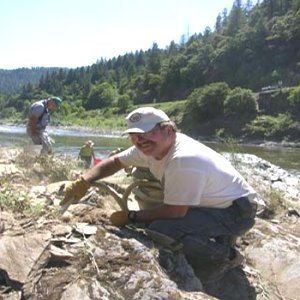 So it did not take us long to organize ourselves into a production team. Several participants were digging material out of the gold traps in the bedrock. Several others were following closely behind, using their vack machines to suck all of the remaining pay-dirt from the gold traps in the bedrock. The pay-dirt was carried in buckets over to several more participants that were screening everything into plastic washtubs. The screened material was then being fed into a Le’Trap plastic sluice that we modified to allow a water feed from a small motorized pump that was providing water from the river.
So it did not take us long to organize ourselves into a production team. Several participants were digging material out of the gold traps in the bedrock. Several others were following closely behind, using their vack machines to suck all of the remaining pay-dirt from the gold traps in the bedrock. The pay-dirt was carried in buckets over to several more participants that were screening everything into plastic washtubs. The screened material was then being fed into a Le’Trap plastic sluice that we modified to allow a water feed from a small motorized pump that was providing water from the river.
From long experience, we have found that the Le’Trap sluice recovers fine gold exceptionally well, providing the water flow through the box is adjusted correctly and the pay-dirt is screened through and 8-mech classifier before being fed into the sluice. We were seeing a nice showing of gold building up in the sluice as soon as we started feeding it! Everyone on my team was pretty excited!
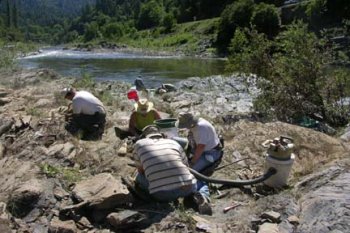
Craig took the second team about an eighth of a mile further upriver where we had discovered a very rich section of high-grade streambed on the final day of our week-long surface mining Project last year. We were initially not sure if anyone had returned there after last year’s Project, because the whole area had been covered up by a thin layer of sand during a very large flood that happened in early January of this year. So Craig’s team got busy right away shoveling sand out of the way, trying to find where we had left off on our earlier Project, and to see if any of the original hard-packed streambed material was still present there. Last year, we were pulling nice big golden flakes out of that material, and sizable gold nuggets off the bedrock!
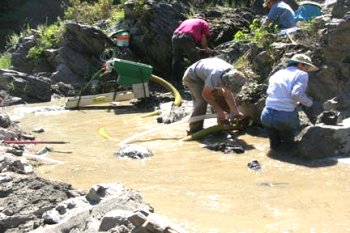 Through just a little sampling, Craig’s team quickly discovered that the hard-pack was still present right where we left off last year. We were amazed that nobody had returned there, since we did so well! This was a great area to develop further, because the natural contours of the bedrock create small pools of water, allowing us to set up a dredge nozzle to feed pay-dirt into the high-banker. The water from the pools is then re-circulated so that we can actually dredge hundreds of feet away from the active waterway.
Through just a little sampling, Craig’s team quickly discovered that the hard-pack was still present right where we left off last year. We were amazed that nobody had returned there, since we did so well! This was a great area to develop further, because the natural contours of the bedrock create small pools of water, allowing us to set up a dredge nozzle to feed pay-dirt into the high-banker. The water from the pools is then re-circulated so that we can actually dredge hundreds of feet away from the active waterway.
Craig and his team did not waste any time getting started, and they were almost immediately rewarded with big flakes and a small treasure in small gold nuggets even before the end of the first day. When I went over to see how they were doing, Craig’s team was bubbling over with enthusiasm, joking with me about how I had made a big mistake agreeing to challenge them in a competition over which team would recover the most gold. While I did not admit it to them at the time; looking at their gold, I knew they were probably right!
Craig’s team started recovering beautiful nuggets right away!
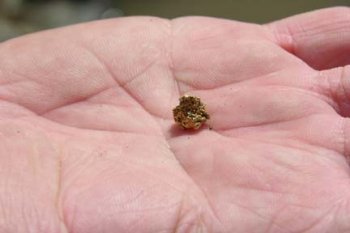 As the guys on my team were feeling really good about all the gold they were recovering in their vack-mining program, we continued into the next two days working out exposed cracks and crevices in the exposed bedrock, while watching an ever-increasing amount of gold accumulate in the Le’Trap sluice. We were doing really well!
As the guys on my team were feeling really good about all the gold they were recovering in their vack-mining program, we continued into the next two days working out exposed cracks and crevices in the exposed bedrock, while watching an ever-increasing amount of gold accumulate in the Le’Trap sluice. We were doing really well!
And while Craig’s team was recovering more gold and bigger pieces, with a lot less effort using a dredge-feed into the high-banker, both Craig and I were concerned that there might not be enough hard-packed streambed present to justify bringing my team over to his
location with a second high-banker. The problem was that we could not see the extent of Craig’s high-grade gold deposit, because the whole area was covered by a thin layer of sand. So Craig came up with a plan to move his high-banker some distance away from where they were already getting good gold, and do another test, to see if the high-grade gold deposit was large enough to bring on a second production team.
One of the biggest problems we continuously face as gold prospectors is that we cannot actually see the gold deposit, because the gold is almost always located down inside of hard-packed composites of sand and gravel. Since we cannot see the gold, we have to do sample tests to find where it is located.
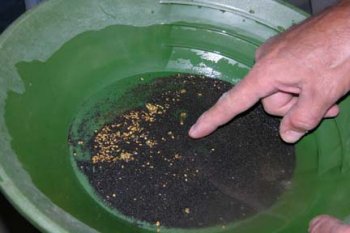 It is always an incredible feeling of fortune when you discover something rich. The best way I can describe it is the feeling you might experience if you hit the bonanza when playing a slot machine and the money just keeps pouring out of the machine onto the floor. But finding a rich gold deposit is better, because you are recovering beautiful, natural gold; Mother Nature’s purest of treasures! The first realization of a rich gold discovery brings out an exhilarated enthusiasm from you that few other things in life can match.
It is always an incredible feeling of fortune when you discover something rich. The best way I can describe it is the feeling you might experience if you hit the bonanza when playing a slot machine and the money just keeps pouring out of the machine onto the floor. But finding a rich gold deposit is better, because you are recovering beautiful, natural gold; Mother Nature’s purest of treasures! The first realization of a rich gold discovery brings out an exhilarated enthusiasm from you that few other things in life can match.
Towards the end of the forth day, when we heard Craig’s team hooping and hollering from an eighth of a mile away, everyone on my team knew that we were finished with our vack mining program for the week. We could always return to that at another time. As much gold as we were recovering, it could not match the large number of beautiful nuggets that Craig’s team was finding in the other location. Craig’s new sample had paid off; the test hole they dredged for us turned up even higher-grade pay-dirt!
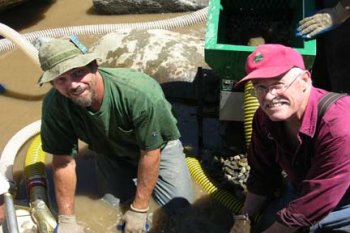 It did not take us long to set up a second high-banker on the fifth day of the project, and we were no longer two separate teams. There is a point on all of these Projects where everyone comes together as a unified group. Part of it comes from the hard work we do together. Part comes from the excitement of making a rich discovery. And part comes from the enthusiasm to work together so that we can recover as much gold as possible in the remaining time that we have. Once the team comes fully together, I usually find myself with little remaining to do as the Project manager. By this time, everyone already knows what needs to be done. There is a very worthwhile group chemistry that happens in these Projects, perhaps similar to what a competitive sports team feels when they are winning games against very challenging opponents. I always feel pride watching my team go at it, working together, laughing and feeling great about what we have accomplished together. Each Project develops its own unique chemistry; almost like something that comes alive. And I always feel a little sadness knowing that our partnership will soon end.
It did not take us long to set up a second high-banker on the fifth day of the project, and we were no longer two separate teams. There is a point on all of these Projects where everyone comes together as a unified group. Part of it comes from the hard work we do together. Part comes from the excitement of making a rich discovery. And part comes from the enthusiasm to work together so that we can recover as much gold as possible in the remaining time that we have. Once the team comes fully together, I usually find myself with little remaining to do as the Project manager. By this time, everyone already knows what needs to be done. There is a very worthwhile group chemistry that happens in these Projects, perhaps similar to what a competitive sports team feels when they are winning games against very challenging opponents. I always feel pride watching my team go at it, working together, laughing and feeling great about what we have accomplished together. Each Project develops its own unique chemistry; almost like something that comes alive. And I always feel a little sadness knowing that our partnership will soon end.
We were rewarded with rich clean-ups on both high-bankers at the end of our fifth day. Excitement levels were about as high as they can get!
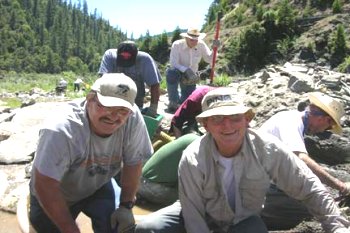
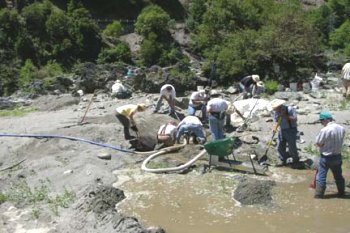
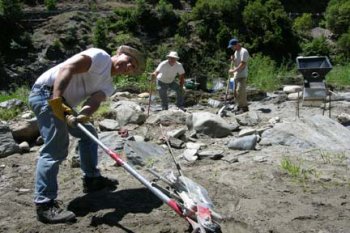
Moving the rock turned out to be a really good move, because underneath it, we found original hard-packed streambed; something the original gold miners must have left behind under that boulder. The pay-dirt was so rich there, that we were actually seeing gold as we moved rocks out of the way!
We produced our richest clean-ups on the sixth and final day of production. Before leaving the area, we filled-in and reclaimed all of the area that we had mined, except for the working face of our excavation. It is important to leave the area looking like we were never even there. This is not a difficult thing to do. We generally do not fill-in the face of an ongoing excavation in rich pay-dirt until the end of a season. This way, it will be easy for other members to pick up right where we left off if you want to mine there this season. It looks like there is a lot more pay-dirt to be mined in that specific location. The Wingate claim is so extensive on the other side, we have hardly even begun to sample the larger area. There are years and years of work remaining down there.
We always devote the seventh day of these projects to pulling our gear off the river and cleaning up all the concentrates that we have accumulated for the week. It takes too much time to clean up the gold every day, so we just accumulate all the gold and concentrates in a single bucket until the end of the week. Friday afternoon found our whole team going through the whole clean-up process. As we do not use any chemicals, we process all of the week’s concentrates down to all of our gold with the use of a Gold Extractor. Then we dry the final product, classify it into different size fractions through a series of finishing screens, and carefully separate the gold. Everyone participates in this process.
 In all, we recovered 64.5 pennyweights of gold (3 ¼ ounces). Of that, 26.3 pennyweights were classified as nuggets. The largest nugget for the week added up to 3.3 pennyweights. There were several other really nice pieces. Participants split 122 gold nuggets between themselves, along with all of the other gold recovered during the project. Our partnership in this adventure dissolved at dinnertime on Friday afternoon. We finished up with a great barbeque.
In all, we recovered 64.5 pennyweights of gold (3 ¼ ounces). Of that, 26.3 pennyweights were classified as nuggets. The largest nugget for the week added up to 3.3 pennyweights. There were several other really nice pieces. Participants split 122 gold nuggets between themselves, along with all of the other gold recovered during the project. Our partnership in this adventure dissolved at dinnertime on Friday afternoon. We finished up with a great barbeque.






